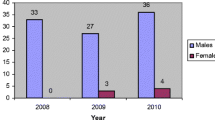Abstract
Background
Pelvic fractures are usually the result of high-energy trauma and may have associated soft tissue and organ damage resulting in significant morbidity and mortality in these patients. Currently, there is little data from Ireland regarding these injuries.
Objective
To study the epidemiology of pelvic fractures presenting to a tertiary referral centre in Dublin.
Methods
Patients referred with a pelvic fracture were identified using the Hospital Inpatient Enquiry System (HIPE) from 1998 to 2008. The patient’s medical notes were reviewed for demographic data, type and mechanism of fracture and associated injuries.
Results
A total of 509 patients were identified over the 10-year period. 466 patients were included in the study. There was a significant male preponderance 76% (n = 354) as compared to females 24% (n = 112). Mean age was 36.5 years (range 16–83). Road traffic accidents (RTA) were the cause in 74% (n = 346) of the cases.
Conclusion
From our study, the typical patient profile is one of a male in his 30’s involved in an RTA requiring acetabular surgery. This is in accordance with previously published international data and highlights the need for specialised units, training in this subspecialty and allocation of resources.





Similar content being viewed by others
References
Giannoudis PV, Grotz MR, Tzioupis C et al (2007) Prevalence of pelvic fractures, associated injuries, and mortality: the United Kingdom perspective. J Trauma 63(4):875–883
Gänsslen A, Pohlemann T, Paul C, Lobenhoffer P, Tscherne H (1996) Epidemiology of pelvic ring injuries. Injury 27(Suppl 1):S-A13-20
Laird A, Keating JF (2005) Acetabular fractures: a 16-year prospective epidemiological study. J Bone Joint Surg Br 87(7):969–973
Geoghegan JM, Longdon EJ, Hassan K, Calthorpe D (2007) Acetabular fractures in the UK. What are the numbers? Injury 38(3):329–333 (Epub 2006 Dec 18).
Demetriades D, Karaiskakis M, Toutouzas K, Alo K, Velmahos G, Chan L (2002) Pelvic fractures: epidemiology and predictors of associated abdominal injuries and outcomes. J Am Coll Surg 195(1):1–10
Population Estimates: Central Statistics Office http://www.cso.ie/px/pxeirestat/database/eirestat/Population%20Estimates/Population%20Estimates_statbank.asp. Accessed 15 December 2009
Ragnarsson B, Jacobsson B (1992) Epidemiology of pelvic fractures in a Swedish county. Acta Orthop Scand 63(3):297–300
Melton LJ, Sampson JM, Morrey BF, Ilstrup DM (1981) Epidemiologic features of pelvic fractures. Clin Orthop Relat Res 155:43–47
Collision Fact Book: Road Safety Authority (2009) http://www.rsa.ie/Documents/Road%20Safety/Crash%20Stats/Collision_Fact_Book_07.pdf. Accessed 15 December 2009
Foreign National Activity: Central Statistics Office (2009) http://www.cso.ie/px/pxeirestat/database/eirestat/Foreign%20National%20Activity/Foreign%20National%20Activity_statbank.asp?SP=ForeignNationalActivity&Planguage=0. Accessed 15 December 2009
Sattler T, Tobbia D, O’Shaughnessy M (2009) Hand injuries in foreign labour workers in an Irish university hospital. Can J Plast Surg Spring 17(1):22–24
Matta JM (1996) Fractures of the acetabulum: accuracy of reduction and clinical results in patients managed operatively within three weeks after the injury. J Bone Joint Surg Am 78(11):1632–1645
Wright R, Barrett K, Christie MJ, Johnson KD (1994) Acetabular fractures: long-term followup of open reduction and internal fixation. J Orthop Trauma 8(5):397–403
Krikler SJ (2010) Problems with pelvic and acetabular fracture data. Injury 41(7):676
Geoghegan JM, Longdon EJ, Hassan K, Calthorpe D (2007) Acetabular fractures in the UK. What are the numbers? Injury 38(3):329–333
Hauschild O, Strohm PC, Culemann U et al. (2008) Mortality in patients with pelvic fractures: results from the German pelvic injury register. J Trauma 64(2):449–455
Pohlemann T, Tosounidis G, Bircher M, Giannoudis P, Culemann U (2007) The German Multicentre Pelvis Registry: a template for an European Expert Network? Injury 38(4):416–423 (Epub 2007 Mar 29)
Nwomeh BC, Lowell W, Kable R, Haley K, Ameh EA (2006) History and development of trauma registry: lessons from developed to developing countries. World J Emerg Surg 1:32
Conflict of interest
None.
Author information
Authors and Affiliations
Corresponding author
Rights and permissions
About this article
Cite this article
Davarinos, N., Ellanti, P., Morris, S. et al. Epidemiology of pelvic and acetabular trauma in a Dublin tertiary hospital: a 10-year experience. Ir J Med Sci 181, 243–246 (2012). https://doi.org/10.1007/s11845-011-0791-4
Received:
Accepted:
Published:
Issue Date:
DOI: https://doi.org/10.1007/s11845-011-0791-4




